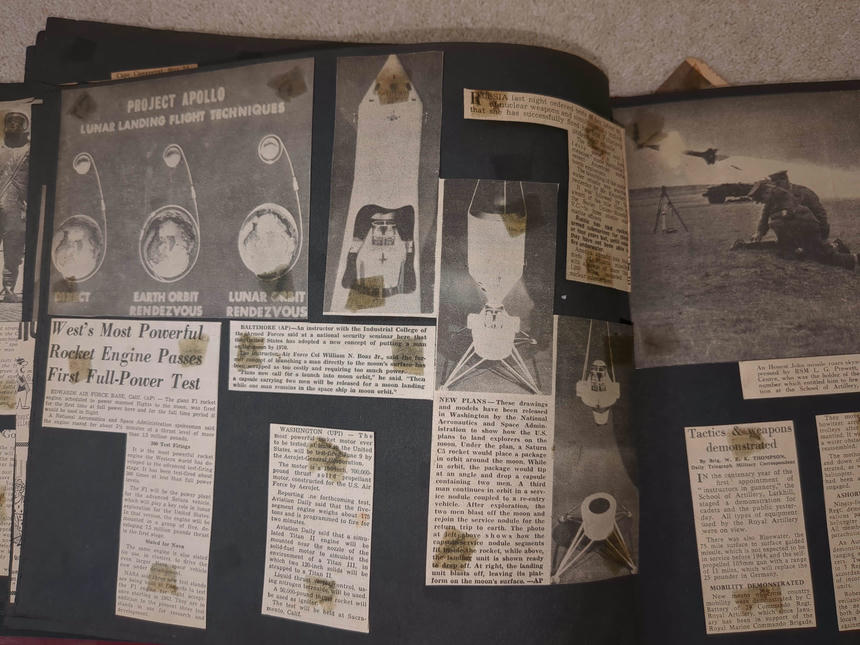Scrapbook 2: May 1962 — F-1, Nova, Titan III, Apollo mission plan

West’s Most Powerful Rocket Engine Passes First Full-Power Test
EDWARDS AIR FORCE BASE, Calif. (AP) — The giant F1 rocket engine, scheduled to power manned flights to the moon, was fired for the first time at full power here and for the full time period it would be used in flight.
A National Aeronautics and Space Administration spokesman said the engine roared for about 2½ minutes at a thrust level of more than 1.5 million pounds.
300 Test Firings
It is the most powerful rocket engine the Western world has developed to the advanced test-firing stage. It has been test-fired about 300 times at less than full power levels.
The F1 will be the power plant for the advanced Saturn vehicle, which will play a key role in lunar exploration for the United States. In that version, the engine will be mounted in a group of five, developing 7.5 million pounds thrust in the first stage.
Slated for Nova
The same engine is also slated for use, in clusters, to drive the even larger Nova space vehicle now under development.
NASA said three new test stands are being built at Edwards to test the F1 engine for flight acceptance starting in 1963. They are in addition to the present three test stands in use for research and development.
NOTE: Photo of the test.
BALTIMORE (AP)—An instructor with the Industrial College of the Armed Forces said at a national security seminar here that the United States has adopted a new concept of putting a man on the moon by 1970.
The instructor, Air Force Col William N. Boaz Jr., said the former concept of launching a man directly to the moon’s surface has been scrapped as too costly and requiring too much power.
“Plans now call for a launch into moon orbit,” he said. “Then a capsule carrying two men will be released for a moon landing while one man remains in the space ship in moon orbit.”
WASHINGTON (UPI) — The most powerful rocket motor ever to be tested, at least in the United States, will be test-fired June 9 by the Aerojet-General Corporation.
The motor is a 100-inch, 700,000-pound thrust solid propellant motor, constructed for the U.S. Air Force by Aerojet.
Reporting the forthcoming test, Aviation Daily said that the five-segment engine weighs about 175 tons and is programmed to fire for two minutes.
Aviation Daily said that a simulated Titan II engine will be mounted near the nozzle of the solid-fuel motor to simulate the environment of a Titan III, in which two 120-inch solids will be strapped to a Titan II.
Liquid thrust vector control, using nitrogen tetroxide, will be used.
A 50,000-pound thrust rocket will be used as igniter.
The test will be held at Sacramento, Calif.
RUSSIA last night ordered tests of her latest type of nuclear weapons and simultaneously indicated that she has successfully fired her first Polaris-type underwater missile.
The Government said the tests were a “forced measure,” made inevitable by recent American nuclear bomb explosions.
The launching of the underwater missile was watched yesterday by Mr. Kruschev.
It was followed by the award of the title Hero of the Soviet Union—Russia’s V.C.—to three atomic submarine officers
Russia has had rocket-armed submarines for three or four years but, until now, they have not been able to fire underwater.
America already has hundreds of Polaris missiles with a range of more than 1,500 miles, mounted in nuclear submarines.
NEW PLANS—These drawings and models have been released in Washington by the National Aeronautics and Space Administration to show how the U.S. plans to land explorers on the moon. Under the plan, a Saturn C5 rocket would place a package in orbit around the moon. While in orbit, the package would tip at an angle and drop a capsule containing two men. A third man continues in orbit in a service nodule coupled to a re-entry vehicle. After exploration, the two men blast off the moon and rejoin the service nodule for the return trip to earth. The photo at left above shows how the capsule-service nodule segments fit inside the rocket, while above, the landing unit is shown ready to drop off. At right, the landing unit blasts off, leaving its platform on the moon’s surface. —AP